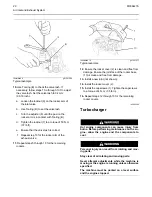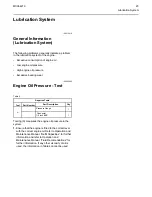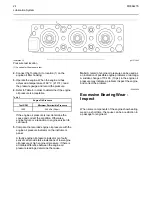
Basic Engine
i06512668
Cylinder Block, Liners and
Heads
The cylinders in the cylinder block are arranged in-
line. The main bearing caps that locate the crankcase
are fastened to the cylinder block with four bolts, two
through the face and two side bolts.
The cylinder liners can be removed for replacement.
The top surface of the cylinder block is the seat for
the cylinder liner flange. Engine coolant flows around
the cylinder liners to keep the cylinder liners cool.
Two O-ring seals around the bottom of the cylinder
liner make a seal between the cylinder liner and the
cylinder block. A sealing compound is applied under
the cylinder liner flange. This makes a seal between
the top of the cylinder liner and the cylinder block.
The engine has a separate cylinder head for each
cylinder. Two inlet valves and two exhaust valves,
which are controlled by a pushrod valve system, are
used for each cylinder. Valve guides without
shoulders are pressed into the cylinder heads. The
opening for the unit injector is located between the
four valves. A lobe on the camshaft moves the
pushrod that operates the unit injector. Fuel is
injected directly into the cylinder.
Coolant goes out of the cylinder block and into the
cylinder head through four openings in each cylinder
head face. Water seals are used in each opening to
prevent coolant leakage. O-rings seal the engine oil
drain line between the cylinder head and the cylinder
block.
Camshaft covers allow access to the camshaft and to
the valve lifters. Crankcase covers allow access to
the crankshaft connecting rods, the main bearings,
and the piston cooling jets. When the covers are
removed, all the openings can be used for inspection
and for service.
i06512669
Pistons, Rings and
Connecting Rods
The piston is a one-piece piston that is a casting of
aluminum alloy. The piston crown carries all three
piston rings. Oil from the piston cooling jets flows
through a chamber which is located directly behind
the rings. The oil cools the pistons. This maintains
the correct operating temperature of the piston. The
pistons have three rings which include two
compression rings and one oil control ring. All the
rings are located above the piston pin bore. Oil is
removed from the wall of the cylinder and returns to
the crankcase through holes in the oil control ring
groove.
The pistons should be checked regularly for wear or
damage. Check that the piston rings are free to move
in the grooves and that the rings are not broken. The
clearance of the piston ring should be inspected
regularly. Remove the piston rings and clean the
grooves. Discard the piston rings. Install new piston
rings in the piston grooves. Check the clearance for
the piston ring by inserting a suitable feeler gauge
between the piston groove and the top of piston ring.
Refer to Specifications, “Piston and Rings” for the
dimensions. Use a suitable feeler gauge to measure
the piston ring gap. Refer to Specifications, “Piston
and Rings” for the dimensions.
The connecting rod has a taper on the pin bore end.
This taper gives the rod and the piston more strength
in the areas with the most load. Two bolts hold the
rod cap to the rod. The connecting rod bearing caps
are matched to the connecting rod and must not be
interchanged. There are different weight bands for
the connecting rods. Ensure that the different weight
bands are taken into account when installing
replacement parts.
10
M0064276
Содержание 4008-30 SD8
Страница 14: ...Starting System Components 14 M0064276 Electrical System ...
Страница 41: ......
Страница 42: ...M0064276 2015 Perkins Engines Company Limited All Rights Reserved 42 December 2015 ...











































